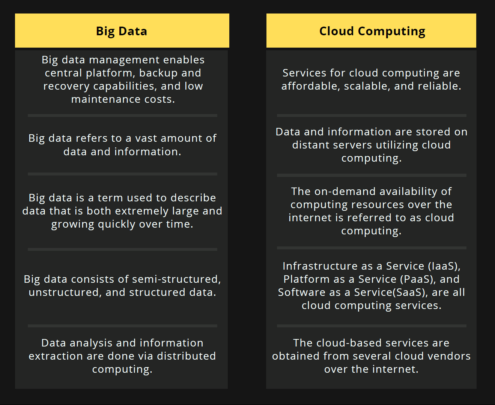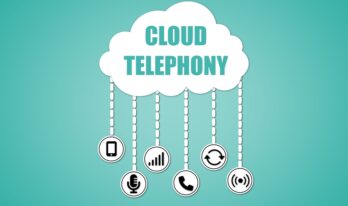In the modern digital era, cloud computing & big data are extremely important. We can utilize cutting-edge infrastructure with cloud computing and simply pay for our time and energy! Big Data is also used to power the creation of cloud applications. The existence of cloud computing services is largely due to big data. Similar to this, the only reason we have services that can accept it and decode it, frequently in a matter of seconds, is why we collect Big Data in the first place. They are a perfect fit because neither would exist without the other.
Now Is The Time For You To Know The Truth About Cloud Computing & Big Data.
What is Cloud Computing?
A network of distant servers located online that are used for data archiving and retrieval is known as cloud computing. The cloud offers numerous IT services, including servers, databases, software, virtual storage, and networking. A virtual platform known as "cloud computing" enables unrestricted storage and access to your data through the internet.
Cloud providers are businesses that supply all of the mentioned services. They enable you to run programs, save and retrieve data, and manage configuration using configuration portals.
Amazon Web Services and Microsoft Azure are two of the greatest cloud service providers currently accessible.
Benefits of Cloud Computing
Today's cloud platforms provide significant outcomes encouraging enterprises to use cloud computing. These key advantages consist of:
Speed
If you need an IT resource or service from the cloud, it is practically always immediately available and prepared for production. This has the significant benefit of allowing the product, service, and go-live date to launch practically directly, as opposed to using traditional infrastructure.
Cost
You pay to use the hardware provided by the host, and if it no longer meets your needs, you can release it and install a more suitable configuration. Because you only pay for the time you really use, you can save a lot of money in this way.
Accessibility
Cloud Computing allows you to access resources, data, services, and applications from anywhere you want, as long as you are connected to the internet. Some tools and techniques will allow you to access the cloud whenever you are not connected to the internet.
Cloud Computing Types
Cloud computing is divided into two categories. One is cloud based-deployment, and another is cloud-based services.
Based on the deployment, cloud computing is divided into three types
- Public cloud
- Hybrid cloud
- Private cloud
Similarly, based on the services it is divided into three categories.
- Software as a Service (SaaS)
- Infrastructure as a Service (IaaS)
- Platform as a Service (PaaS)
Some popular organizations like Spotify, Netflix, Pinterest, Expedia, etc. use the AWS cloud platform to store a large number of data.
Advantages of Cloud Computing
- Data backup and restoration
- Collaboration is improved, and accessibility is excellent
- low cost of maintenance
- Self-service on demand.
What is Big Data?
Big Data is a group of vast data collections that traditional computing methods are unable to process. The term applies to both the data and the many supporting frameworks, tools, and methodologies.
Big data analysis can produce insights that help with decision-making and provide assurance when making critical business actions. Big data's significance is not just dependent on the volume of data you have. Its worth depends on how you use it.
Advantages of Big Data
- The modern consumer is quite picky. He interacts with bystanders on social media and considers his alternatives before making a purchase. After purchasing a product, a consumer wants to be acknowledged and rewarded. Big data will provide you with useful information that you may utilize to interact with your clients directly in the present.
- Big data enables you to redesign the goods and services you offer. Your ability to produce new items is aided by knowledge of what customers think of your offerings, such as through unstructured social networking site text.
- Using big data, you may test various iterations of CAD (computer-aided design) images to see how little adjustments affect your process or end result. Big data is therefore quite useful in the production process.
- You may diversify your revenue streams, thanks to big data. Big data analysis can provide you with trend data that may enable you to develop an entirely new source of income.
- It must be active if you want your website to compete in the crowded internet market. Big data analysis enables you to tailor your website's appearance, content, and overall experience to each user based on factors such as sex and nationality.
Challenges
- Organizations frequently put off data security because they are preoccupied with comprehending and analyzing the data. As a result, unprotected data eventually becomes a haven for hackers.
- The exponential rise of raw data is one of the problems with big data. The databases and data centers house enormous volumes of data, which is still expanding quickly. The exponential growth of data makes it challenging for organizations to properly store this data.
- There are many different Big Data tools, but picking the wrong one might waste your time, effort, and money.
Relationship between Cloud Computing & Big Data
Software as a Service (SaaS) is a popular business model used by cloud computing providers to make data processing simple for clients. A terminal can accept specific commands and arguments, but everything can also be done through the website's user interface. Database management systems, identity management systems, machine learning capabilities, and other items are frequently included in this package.
Many complex, network-based systems produce big data. It may be in a conventional format or a non-conventional one. If the data isn't in a standard format, machine learning and artificial intelligence from the cloud computing provider might also be utilized to standardize the data.
From there, the data may be accessed and used in a variety of ways, thanks to the Cloud Computing platform.
Another similarity between big data and cloud computing is that big data analytics now take a fraction of the time they once did.
Difference between Cloud computing & Big data
Although big data and cloud computing are two distinct concepts, they are frequently used in conjunction in literature because of how well they work together. The following are the points that will form a clear distinction between Cloud computing and Big data.
How is cloud computing used in big data?
Big Data is a methodology for data analysis made possible by recent advancements in design and technology. Big data adoption costs are prohibitive for small and medium-sized organizations due to the required hardware and processing resources. Small and medium-sized organizations can implement big data thanks to cloud computing.
A programming approach called MapReduce is used to process big data. The MapReduce paradigm typically calls for parallel processing and networked connected storage. Small and medium-sized businesses are frequently unable to dedicate the necessary computing resources to meet the demands of MapReduce programming. A third party provides on-demand network access to computing resources through cloud computing.
Which is better big data or cloud computing?
Big Data and Cloud computing are cutting-edge technologies crucial to IT businesses. Additionally, non-IT companies also profit from it. With the use of a network connection, cloud computing primarily focuses on the provision of computer resources and services. However, Big data focus on finding solutions to issues while processing and generating vast amounts of data.
Big data makes use of the information we can get before purchasing an organization and offers insights that will be useful to the company in the future. On the other hand, when it comes to deployments, cloud computing offers flexible and speedy service, ensuring the success of an organization's production lines.
What are the 4 types of cloud computing?
The four types of cloud computing are as follows:
Public cloud
A true example of cloud hosting is the public cloud, in which the service provider offers services and infrastructure to many clients. On the other side, clients have no influence over the servers' location. Private clouds and public clouds differ slightly in terms of structural layout. Public cloud computing is cost-effective because it has minimal capital and ongoing operating expenses.
Private cloud
The private cloud provides a secure cloud platform for cloud computing services. Typically, a firewall that is controlled by an organization's IT department protects the environment. In a private cloud, the user has more direct access to the data.
Businesses with critical or unforeseen needs, availability requirements, administration demands, and mission-critical tasks are best suited for the private cloud.
Hybrid cloud
Public and private clouds are combined in hybrid clouds. It has two or more cloud servers, which can be a community, private, or public. Because hybrid clouds can exceed provider boundaries, they cannot simply be divided into public, private, or hybrid clouds. In this case, resources are offered by internal or external suppliers.
Organizations can choose to store non-critical resources like development and test workloads in public clouds. On the other hand, critical or complex workloads can be stored in a private cloud. Scalability, security, and adaptability are well-known advantages of hybrid clouds.
Community cloud
In a community cloud, numerous entities that are a part of the same community—such as banks and trading companies—share cloud resources. This configuration is generally shared by numerous businesses from the same group of people who are concerned about computing.
In a community cloud, multiple entities that are a part of the same community—such as banks and trading companies—share cloud resources. This configuration is generally shared by numerous businesses from the same group of people who are concerned about computing.
What are the risks of using the cloud?
When utilized to store or send information and data that is already available to the public, the cloud poses little risk. Using the cloud might carry significant risks when transmitting or storing confidential information subject to legal or regulatory restrictions.
Risks can include the possibility of data loss, theft, corruption, or exposure to unauthorized users. These dangers have the potential for legal, financial, and reputational consequences.
What are the 5 V’s in Big Data?
The following are the five V’s in big data.
- Volume: The volume is reflected in a sizable amount of data kept in data warehouses. Since there is a chance that the data will reach arbitrary heights, it must be reviewed and processed. which could be between terabytes and petabytes or more.
- Value: Raw data has no value or use until it is transformed into something useful. We can glean knowledge that is useful.
- Velocity: Velocity essentially introduces the rate at which real-time data is generated.
- Veracity: In a tangible form, we can describe data veracity as the caliber of the data examined. It essentially has to do with how trustworthy the data is.
- Variety: Big Data consists of data that has been acquired from various sources and is structured, unstructured, and semi-structured. This diverse range of data necessitates the use of distinct and suitable algorithms and extremely varied and specific analyzing and processing procedures.
Conclusion
The importance of Big Data and Cloud Computing in our digital world should not be underestimated, to sum up. People with excellent ideas but little resources have a possibility for business success when the two are connected. Additionally, they let established companies use data that they collect but couldn't previously analyze.
Businesses can also gain insights based on the Big Data they've gathered by using more contemporary components of cloud infrastructure's traditional "Software as a Service" approach, such as artificial intelligence. Businesses may benefit from all of this for a small charge with a well-thought-out system, leaving rivals who refuse to adopt these new technologies in the dust.
In conclusion, cloud computing services are largely due to big data. Similar to this, the only reason we have services that can accept it and decode it, frequently in a matter of seconds, is why we collect Big Data in the first place. They are a perfect fit because neither would exist without the other.
Recommended For You:





